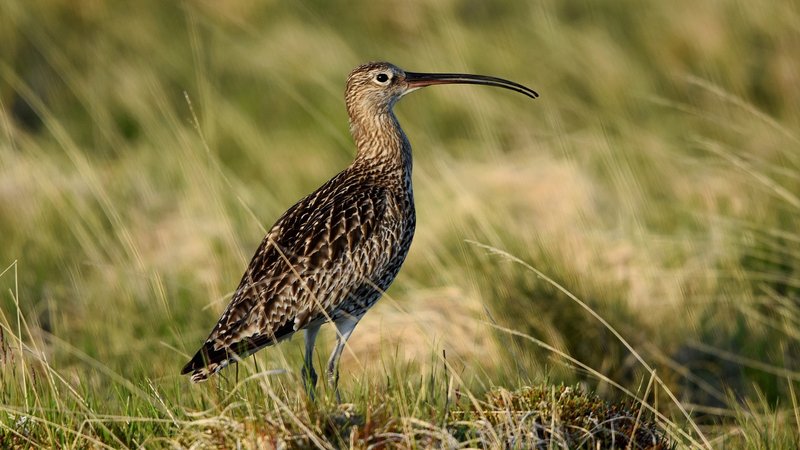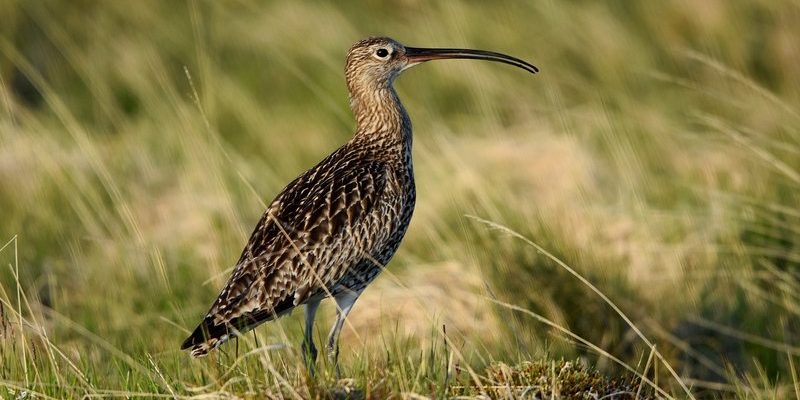
When you think of birds, you might picture songbirds flitting about, or perhaps majestic eagles soaring overhead. But have you ever considered the curlew? This striking bird, with its long legs and even longer beak, has a unique charm that captures the essence of coastal habitats. Just imagine watching it wade through shallow waters, probing the mud for food—it’s a wonderful sight.
The curlew is not just beautiful; it plays a vital role in its ecosystem. With several species spread across different continents, these birds are more than just a pretty face. They offer us insights into environmental health and the interconnectedness of animal life. So let’s dive into the world of the curlew and discover what makes this shorebird so fascinating.
What is a Curlew?
The curlew is a wading bird belonging to the family Scolopacidae, which includes other shorebirds like sandpipers and godwits. There are different species of curlews, but the most recognized are the Eurasian Curlew and the Whimbrel. These birds can be identified by their distinctive long, downward-curving bills, which they use to search for food buried in the mud and sand.
Curlews are large birds, often measuring between 16 to 25 inches in length, depending on the species. Their plumage is typically a mix of browns and grays, designed to provide perfect camouflage against their natural surroundings. With long legs and a long neck, they’re built for both agility and grace, moving through their habitats with ease.
You might be wondering why their long bills are so important. Think of it like having a specialized tool for a particular job. The curlew’s bill helps them dig into soft ground to find worms, crustaceans, and other tasty morsels. This specialization is key to their survival and success in various ecosystems.
Physical Characteristics
Curlews have some striking physical features that make them easily recognizable. Their long, slender bodies are complemented by long, thin legs, making them adept at navigating wetland habitats. The most notable characteristic, however, is their bill. Depending on the species, it can range from 5 to 8 inches in length. This unique feature is adapted for probing into mud and sand, allowing the curlew to hunt for food beneath the surface.
In addition to their long bills, curlews have large, rounded wings that enable them to fly at impressive speeds. They can reach speeds of up to 40 miles per hour during migration. Their flight pattern is characterized by a series of graceful, powerful flaps that can be mesmerizing to watch, especially against the backdrop of a setting sun.
Interestingly, gender differences in curlews can be subtle but noticeable. Males tend to be slightly smaller than females, and their plumage can sometimes vary in shade, with males displaying a slightly lighter coloration. This difference can help during mating displays, where visual cues play an important role in attracting partners.
Habitat and Distribution
Curlews are found in various habitats depending on the species and season. They primarily inhabit coastal areas, including mudflats, estuaries, and sandy beaches. Some species, like the Eurasian Curlew, also prefer grasslands and wetlands during the breeding season. This adaptability allows them to thrive in different environments, but they always return to water-rich areas for feeding.
During migration, curlews can traverse thousands of miles. The Whimbrel, for example, is known for its incredible long-distance flights from breeding grounds in Canada and Alaska to wintering sites in Central and South America. These journeys are not only remarkable feats of endurance but also highlight the importance of preserving critical habitats along their migratory routes.
If you’re wondering where to spot these beautiful birds, look no further than shorelines during the spring and fall migrations. Watching curlews as they forage along the water’s edge can be a delightful experience. Their presence often signals healthy ecosystems, making them essential indicators for environmental conservation efforts.
Diet and Feeding Habits
Curlews are primarily carnivorous and have a diverse diet, which varies based on their habitat and the season. They primarily feed on invertebrates like worms, crabs, and mollusks. Their long bills allow them to probe into the ground or sand, searching for hidden treasures beneath the surface. When you see a curlew, it’s likely hard at work, searching for its next meal.
During feeding, curlews often use a technique known as “visual foraging.” This means they look for movements or disturbances in the mud that might indicate the presence of food. Once they spot potential prey, they’ll skillfully use their bills to dig it out. This method is not only efficient but also highlights their adaptability to different environments and food sources.
Interestingly, curlews can alter their feeding habits based on the season. In the breeding season, they might focus more on protein-rich foods to support egg production and chick development. In contrast, during migration, they might scavenge more broadly to build up energy reserves for their long journeys.
Reproduction and Nesting
Curlews are monogamous during the breeding season, often forming strong pair bonds. Their courtship displays can be quite elaborate, involving aerial displays and distinct vocalizations. Males often perform a series of calls and flights to attract females. This is where their stunning vocal repertoire shines, making the breeding season a truly magical time for these birds.
Nesting typically occurs in open fields or grasslands, away from potential predators. The female will create a shallow scrape in the ground, usually in tall grass or near water. She lays a clutch of 3 to 5 eggs, which are camouflaged to blend in with their surroundings. This natural camouflage helps to protect them from predators, as the eggs can easily go unnoticed.
After hatching, both parents take part in raising the chicks. Curlew chicks are precocial, meaning they are relatively mature and mobile shortly after hatching. They can feed themselves almost immediately. However, they still rely on their parents for protection from predators during this crucial early life stage. Watching a family of curlews working together to nurture their young is a heartwarming testament to the bonds these birds share.
Conservation Status
Unfortunately, many curlew species face threats due to habitat loss, hunting, and climate change. The Eurasian Curlew, for instance, is listed as a Near Threatened species, primarily due to declining populations across Europe. Coastal development, agriculture, and pollution have significantly impacted their breeding and feeding grounds.
Conservation efforts are crucial to ensuring the survival of these beautiful birds. Initiatives aimed at preserving their natural habitats, along with awareness campaigns to educate the public about curlew conservation, are essential. Many organizations work tirelessly to create protected areas that provide safe nesting and foraging grounds.
Every little effort counts. By supporting conservation programs or even just being mindful about our environmental impact, we can all play a part in protecting curlews and their habitats. Whether you’re a birdwatcher or simply someone who enjoys the beauty of nature, taking action can make a difference in the lives of these remarkable birds.
Interesting Facts About Curlews
| Common Species: | Eurasian Curlew, Whimbrel, Alaskan Curlew |
| Size: | 16 to 25 inches in length |
| Wingspan: | Up to 40 inches |
| Diet: | Invertebrates (worms, mollusks, crabs) |
| Breeding Season: | Spring to early summer |
| Migration Distance: | Up to 4,000 miles |
| Life Span: | Up to 10 years in the wild |
The curlew is a captivating bird that serves as a reminder of nature’s beauty and fragility. From its unique physical characteristics to its vital role in the ecosystem, understanding the curlew helps us appreciate the intricate connections within our environment. Whether you’re a seasoned birdwatcher or just someone intrigued by wildlife, the stories of these shorebirds can easily draw you in.
As we learn more about the challenges they face, it becomes clear that we must take action to protect their habitats and ensure that future generations can enjoy their presence. So the next time you’re near the coast or a wetland, keep an eye out for the elegant curlew. You might just catch a glimpse of this wonderful bird, gracefully navigating its world.
FAQ
What is the difference between a curlew and other shorebirds?
The primary difference between curlews and other shorebirds lies in their physical characteristics, particularly their long, downturned bills. While many shorebirds have similar features, curlews stand out due to their size and bill shape. Additionally, curlews are often more vocal than many other shorebird species, making their calls a distinctive part of their identity.
Are curlews migratory birds?
Yes, many curlew species are migratory. For instance, the Whimbrel migrates thousands of miles each year, leaving its breeding grounds in the Arctic to spend winter in warmer areas like Central and South America. Their migration routes often align with coastal areas where they can find suitable feeding grounds.
How can I help protect curlews?
There are several ways you can help protect curlews and their habitats. Supporting conservation organizations that focus on habitat preservation is crucial. Additionally, spreading awareness about the importance of curlews can help others understand their role in the ecosystem. Lastly, if you live in areas where curlews are common, practicing responsible birdwatching without disturbing their nesting sites is essential.
What do curlews sound like?
Curlews have a distinct and often haunting call that varies by species. The Eurasian Curlew has a long, melodic whistle, while the Whimbrel’s call is shorter and more rhythmic. Listening to curlews in their natural habitat can be an unforgettable experience that highlights their uniqueness and charm.
Do curlews mate for life?
Curlews typically form strong pair bonds during the breeding season, but they do not necessarily mate for life. While some pairs may return to each other year after year, others may change partners each season. Their commitment during the breeding season, however, is quite strong, providing a stable environment for raising their young.
Where can I find curlews in the wild?
You can find curlews in various habitats, particularly coastal areas like mudflats, beaches, and estuaries. They’re also spotted in grasslands and wetlands during the breeding season. If you’re interested in birdwatching, local parks and nature reserves near water sources are great places to start your search for these magnificent birds.
What threats do curlews face?
Curlews face multiple threats, including habitat loss due to coastal development, agriculture, and pollution. Climate change also poses risks, as shifting weather patterns can impact their migratory routes and breeding success. Conservation efforts are vital to mitigate these threats and protect curlew populations.
Can curlews be kept as pets?
It’s illegal to keep curlews as pets in many places due to their status as wild birds. They are best appreciated in their natural habitats, where they can thrive and contribute to the ecosystem. Observing them in the wild provides a more rewarding experience than attempting to keep them in captivity.
How do curlews care for their young?
Both parent curlews take part in caring for their young. After the chicks hatch, they are mobile and can feed themselves quickly. However, the parents provide protection from predators and guide them to safe feeding areas. This cooperative care ensures a better chance of survival for the chicks during their vulnerable early weeks.
What is the lifespan of a curlew?
The lifespan of a curlew can vary by species, but most generally live up to 10 years in the wild. Factors such as predation, habitat quality, and food availability can significantly influence their longevity. In protected environments, some curlews may live even longer, showcasing the importance of healthy habitats for their wellbeing.
Are there any cultural significances associated with curlews?
Curlews have appeared in various cultures’ folklore and traditions, often symbolizing the beauty and fragility of nature. Their evocative calls have inspired poets and musicians throughout history. In some cultures, they are considered omens of change or harbingers of good fortune. Understanding these cultural connections can deepen our appreciation for these exceptional birds.

